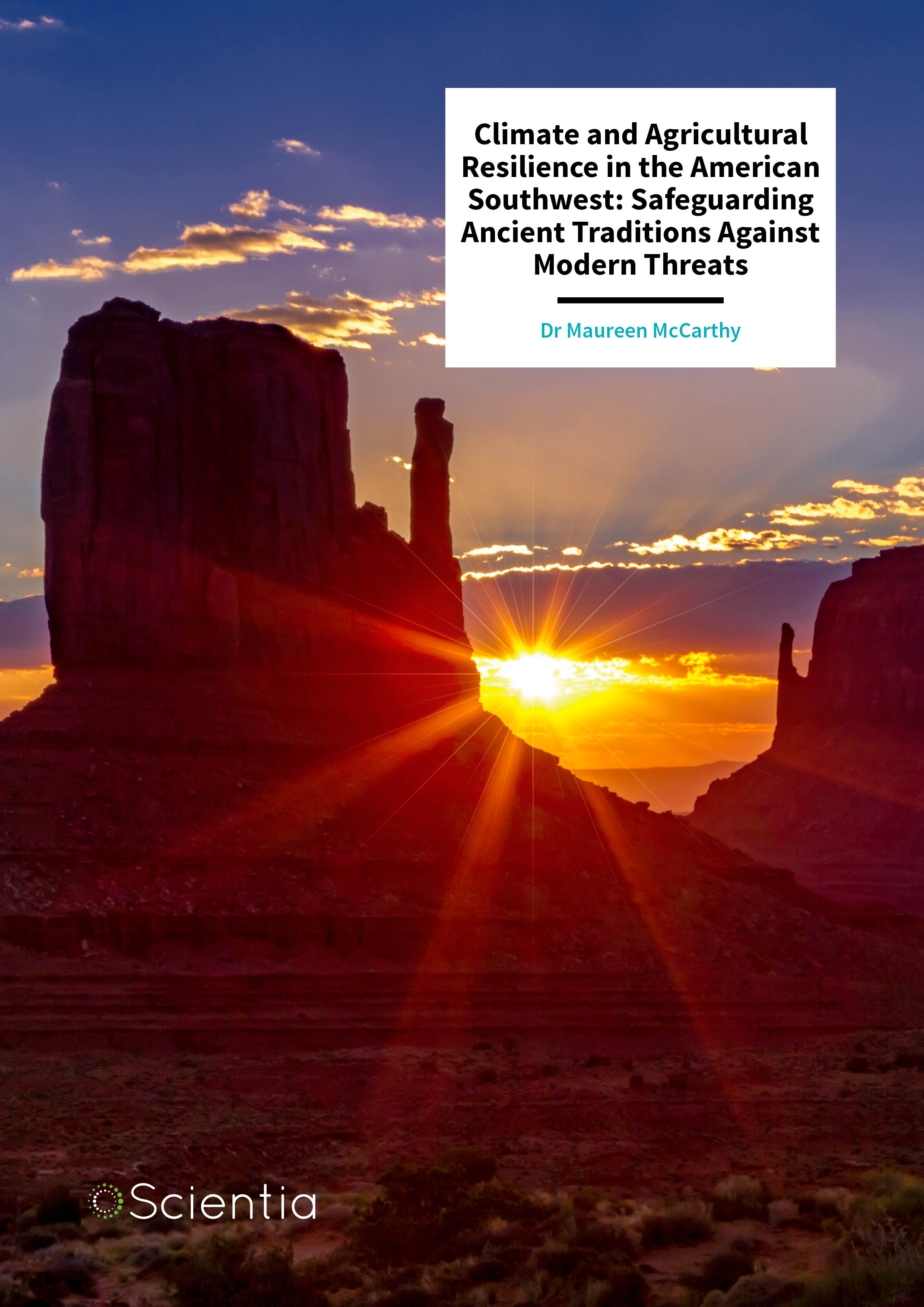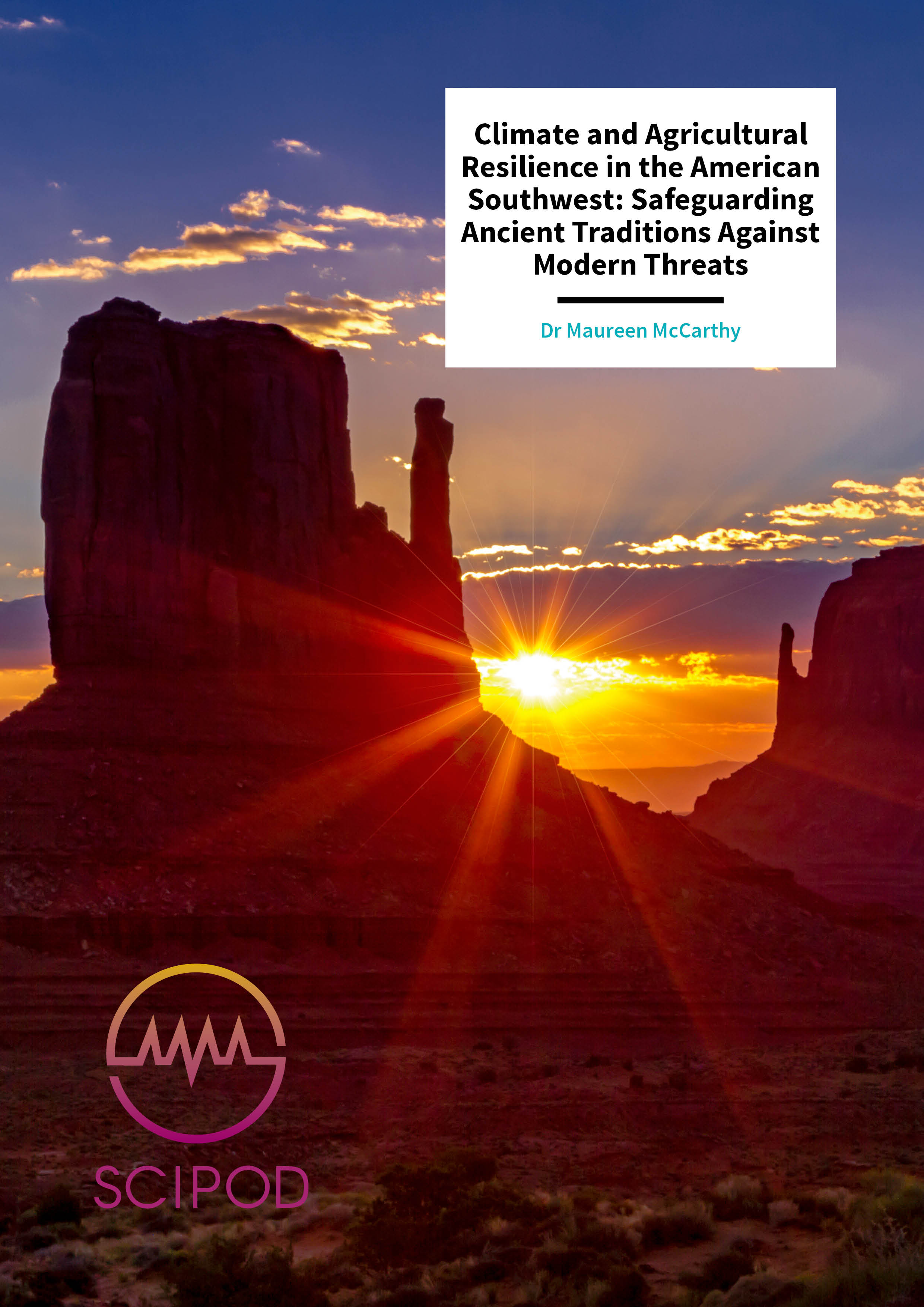Dr Maureen McCarthy – Climate and Agricultural Resilience in the American Southwest: Safeguarding Ancient Traditions Against Modern Threats
Sustaining the availability of clean water is one of the greatest challenges humanity will face, as climate change leads to hotter, more extreme weather patterns that disrupt normal snow and rainfall worldwide. These changes are predicted to hit arid climates particularly hard, and the effects in such areas are already being felt in many countries across the globe. Dr Maureen McCarthy at the University of Nevada and the Desert Research Institute is working with Native American communities to help promote and preserve ancient tribal agricultural practices and water use in the United States.
Global climate change is likely to be the paramount challenge facing humanity over the next hundred years. Driven by human-induced disruptions to the carbon cycle, largely due to burning fossil fuels and worldwide deforestation, climate change threatens to drastically alter our way of life through reduced water availability, widespread food insecurity, and extreme weather events. These effects are expected to hit certain communities particularly hard, and those that rely on agriculture in arid climates are predicted to be some of the most affected.
Native American reservations in the United States are largely relegated to arid climate zones with limited access to water resources. Many of these communities are heavily dependent on water from rain and snowpack to support rangeland livestock and dryland, and irrigated farming of crops for traditional uses and trade. Dr Maureen McCarthy leads two multimillion-dollar research projects with two goals: studying the effects of climate change as they unfurl, and working with Native American communities to leverage both native wisdom and western science to enhance tribal agricultural resilience. Resilience is defined as the ability of communities to adapt to more frequent droughts and extreme weather events that go hand in hand with warming temperatures.
Her team’s ‘Native Water on Arid Lands’ project focuses on tribal reservations in the American Southwest and Great Basin – areas that are normally subject to dry climatic conditions. These areas are likely to be hit hard by reduced water availability as temperatures warm and annual snowpacks in the surrounding mountains decline. Her other project, entitled ‘Water for the Seasons’, models climate impacts on water sustainability in a representative snow-fed arid land river system with competing demands from urban communities, agricultural producers, and tribal communities dependent on river flows for fish and crops.
‘It was very humbling and restorative when I began working with the Native American communities to realise that native wisdom complements and strengthens western science and both are needed to understand the impacts of climatic change on water and agriculture for the millennium to come. Community resilience derives from both traditional and scientific sources of knowledge.’
Throughout the Western United States, water is primarily sourced from snowpack, which accumulates in winter and gradually melts to feed irrigated agricultural lands, urban communities, and energy production throughout the dry season. As global temperatures rise, this critical cycle is becoming disrupted as more winter precipitation falls as rain (not snow) in the mountains, decreasing nature’s vast reservoir of water needed to support crops, livestock, and people throughout the dry season. In addition, hotter summers cause more water to evaporate from rivers, streams and plants, decreasing water supplies and increasing demand.
Indeed, increasing temperatures are disrupting nature’s clock at an unprecedented pace, resulting in shorter winters, longer summers, earlier springs, later falls, and challenging both rural and urban societies’ ability to adapt. Punctuating these changes are more frequent extreme storms and floods and longer droughts, which further degrade community resilience. These challenges are not unique to the Western United States given that over 50% of the world’s population relies on snow from either annual snowpack or glacier runoff as their primary source of water.
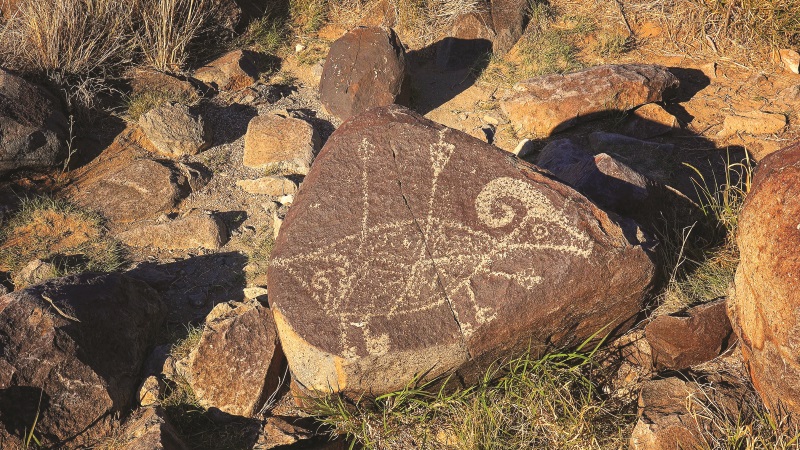
Both of Dr Maureen McCarthy’s projects involve partnerships with tribal communities – joining western science and traditional knowledge to enhance tribal agriculture and create opportunities to educate and promote the careers of Native American students and researchers, while simultaneously respecting the agricultural, ecological and cultural integrity of American Indian communities. Many of the tribal members she engages with have a deep appreciation of the need for sustainable agriculture and land-use practices, and are eager to tie ancient traditions to modern conservation science. As Dr McCarthy’s colleague, Dr Karletta Chief (member of the Navajo Nation and Associate Professor at the University of Arizona), explains: ‘Indigenous peoples in North America have a long history of understanding their societies as having an intimate relationship with their physical environments. Their cultures, traditions, and identities are integrally linked to the land, water and sacred places of their homelands.’
Dr McCarthy feels fortunate to work with Native American tribes, whose long legacy of living in harmony with the land imbues innate understanding of human adaptation to ecological and climatic change. ‘It was very humbling and restorative when I began working with the Native American communities,’ she says, ‘to realise that native wisdom complements and strengthens western science and both are needed to understand the impacts of climatic change on water and agriculture for millennia to come. Community resilience derives from both traditional and scientific sources of knowledge.’
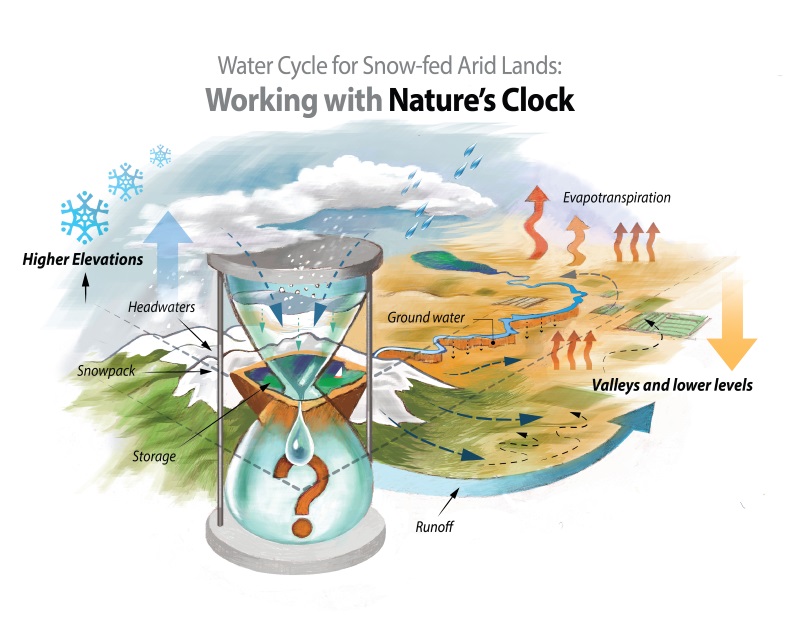
Winter Snows and Summer Crops
Having started in 2014, ‘Water for the Seasons’ (WftS) is a multi-year research project working with tribal and non-tribal water, agriculture, and natural resource managers in the Truckee-Carson River System (TCRS) of Northern California and Nevada. Project goals are to develop an integrated suite of hydroclimatic and socioeconomic models to assess the climate resiliency of the TCRS and to understand how this approach can be scaled or transferred to snow-fed arid systems around the world.
Urban, rural and tribal communities along the Truckee and Carson Rivers in Nevada are located in the arid lands of the Great Basin in the State of Nevada. Nevada is the driest state in the nation, receiving less than 190 mm of rainfall annually with northern Nevada depending entirely on water from melting snowpack in the Sierra Nevada Mountains. The TCRS is representative of water challenges throughout the Western United States with a compact geography that is only 193 km from headwaters to terminus. Competing demands for water originate from urban growth, industrial development, rural agriculture, and measures to protect endangered fish species and other natural resources.
Communities in this region rely on accumulated snow in the Sierra Nevada mountain range that melt in spring to feed rivers, streams, reservoirs, and aquifers that, in turn, provide water throughout the dry summer and fall seasons. These areas are facing increasing challenges, as milder winters mean less snow to feed the spring runoff and more winter floods, which arrive too early for agricultural production or to be captured by reservoir operations.
Dr McCarthy and her colleagues are developing climate scenarios informed by both scientists and stakeholders, using these scenarios to model water availability, integrating the hydroclimatic models with socioeconomic models of human behaviour to better understand system resiliency, and finally, assessing how well this approach transfers to other snow-fed arid landscapes around the world.
Thus far, the team has been successful in building models that incorporate insight about how diverse communities – urban planners, rural farmers and ranchers, Native American fisherman and farmers, and natural resource managers – respond to changes in water supplies due to droughts, warming temperatures, and increased inter-annual variability it precipitation. They have developed a suite of scenarios based on historical data, paleoclimatic records, and global climate models to probe the sustainability of water supplies in a future of longer droughts punctuated by extremely warm, wet seasons. Water availability in the TCRS depends on snowpack accumulation, river basin geography/topography, groundwater/surface-water interactions, and reservoir operations governed by complex legal doctrines for allocating water to water right holders and maintaining stream flows to protect endangered fish. With these data, the researchers and stakeholders can estimate inter-annual water availability and assess alternative water management, agriculture, and urban development strategies to enhance community resilience in a changing climate.
With these models in hand, WftS researchers hold regular workshops with stakeholders from the three tribes (Washoe, Pyramid Lake Pauite, and Fallon-Shoshone Paiute) and other water users and managers, presenting their results and taking feedback on alternative water management strategies. These meetings help the various parties understand one another’s water usage and needs, while providing valuable information to the research team about what management strategies might be socially, economically, and culturally practical. They also help the team better understand the times of year when communities are most vulnerable to water stress, and how changes in water management during these periods can build more climate resilient systems.
Thanks to the WftS team, the Truckee Meadows Water Authority is developing a new Drought Contingency Plan incorporating their data with economic models to help ensure water security for the growing urban areas. Further, the team’s techniques are being used to build regional climate scenarios for the American Southwest to predict areas of sociocultural, ecological, and infrastructure vulnerabilities due to climate change.
WftS researchers are collecting data in the Carson Valley on the viability of strategies such as managed aquifer recharge, which replenishes groundwater by directing excess water to dormant agricultural fields during warm winter storms that can, in turn, be pumped for irrigation during the growing season. The team plans to use this data to assess alternative crop and irrigation practices that can both increase surface water use efficiency and replenish groundwater supplies. They are also working to understand the economic drivers for land and water management decision-making and the willingness of various stakeholders to participate in conservation programs and water sharing economies.
Finally, the researchers are investigating how the insights gleaned from this region are applicable to other snow-fed arid regions around the world, thus testing the applicability and transferability of this approach to help other communities facing water sustainability challenges due to climate change. As the WftS project transitions into its final years, Dr McCarthy and her team are continuing to build on these successes and share knowledge about water sustainability and climate resilience with the scientific community, urban water managers, natural resource managers, and rural farmers and ranchers.
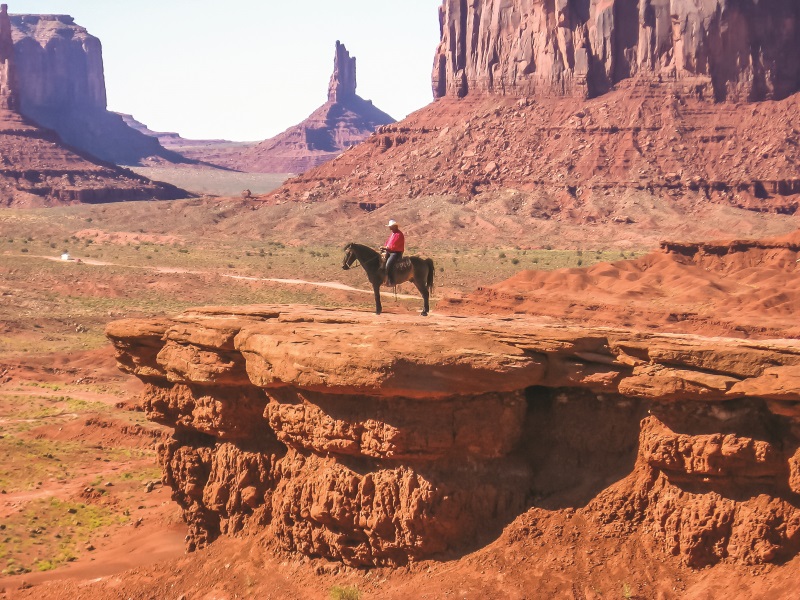
Native Waters in the Desert
Indigenous communities in North America have ancestral ties to the land that span thousands of years, rooted in agrarian cultural and spiritual practices intimately associated with the health and wellbeing of terrestrial and aquatic natural resources. The world view of Native American communities is ecosystem- and watershed-based, inextricably bound to the land and supporting a holistic approach to living in balance with the drivers of change in air, land and water.
American Indian land tenure and water rights laws enacted by the US Government during the 19th and 20th centuries forced Native Americans to either relocate or consolidate on designated reservations. It also fractionated tribal land ownership and mandated conversion of traditional agriculture to Western agrarian practices.
In the American Southwest and Great Basin Desert, Native Americans lived on expansive ancestral lands for thousands of years before European settlement, sustaining themselves through a combination of hunting, fishing, gathering seeds and plants, raising livestock and crops, and trading with neighbouring communities. Sustaining these agricultural practices has become increasingly difficult in recent years due to rapid changes in climate and the growing demands for water and land by the surrounding non-tribal communities. In addition, most Native American communities face daunting socioeconomic challenges including high levels of poverty and disease that influence land-use decision making by tribal governments.
‘Native Water on Arid Lands’ (NWAL) is a multimillion dollar five-year project involving diverse tribal partners from reservations across the largely arid lands of the American Southwest. NWAL’s primary goal is to bring scientists together with tribal farmers, ranchers, resource managers, educators, and council members, to assess the impacts of climate change on water resources and to enhance the resiliency of traditional and trade agricultural practices on Native American reservations.
Dr McCarthy and her colleagues are accomplishing this goal through researching barriers and opportunities to improve the availability, accessibility and use of water for agriculture through a combination of traditional knowledge, altered crop and livestock practices, and water trading agreements. Through a partnership with FALCON – a network of 37 Tribal Colleges & Universities in the United States – the NWAL team is building capacity and creating educational opportunities for tribal members, thus supporting the next generation of tribal leaders that could shape policy and practice for water and agriculture reservations.
Native American researchers and outreach educators on the NWAL team are essential to creating cultural bridges between the scientific and tribal communities to share and co-produce the knowledge needed to enhance the long-term health and productivity of Native American agriculture.
NWAL researchers are evaluating how tribal water rights impact water availability and usage for sustenance and trade agriculture. They are also using global climate model data to assess the impacts of warming temperatures on water supplies at the river basin and watershed scales. The team has provided the tribes participating in the study with reservation-specific downscaled projections of future temperature and precipitation patterns under different carbon emission scenarios. These data are used to estimate changes in growing season timing and duration, minimum/maximum temperatures, snow vs. rainfall profiles, and precipitation timing and intensity.
Since 2015, the NWAL team has been hosting an annual Tribal Summit, where scientists and Native American farmers, ranchers, resource managers, and community leaders convene to discuss traditional and production agriculture practices, water challenges and developments and to share knowledge about community and agricultural resilience. The summit features workshops and panel sessions devoted to agricultural resilience issues, such as innovative water trading arrangements, rangeland conservation practices, groundwater/surface-water management, and traditional knowledge of seeds and cultivation practices that enhance drought resilience.
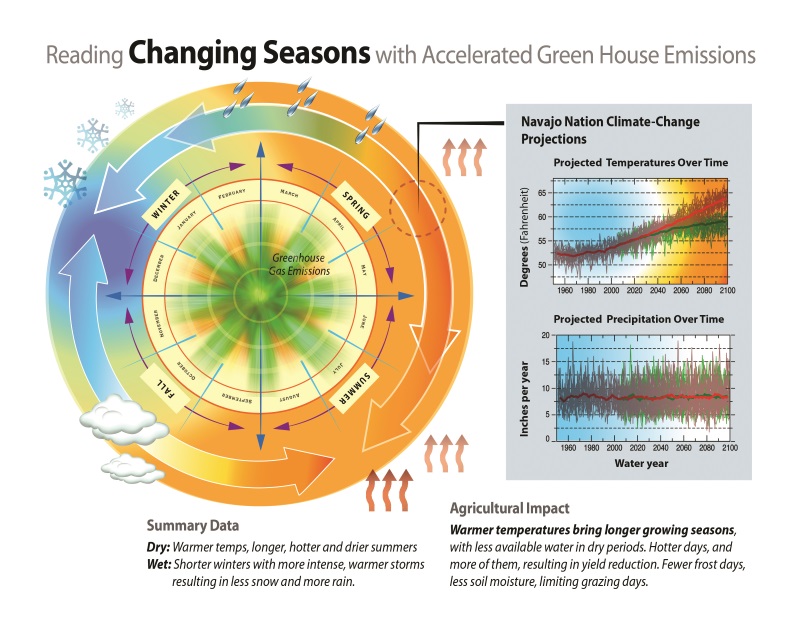
CREDIT: Ron Oden Designs
Faculty members and students from the Tribal Colleges and Universities are partnered with NWAL researchers to develop agricultural research projects on reservations. For example, faculty members at Aaniiih Nakoda College (ANC) in Montana are working with an agricultural ecologist from the Desert Research Institute to evaluate the effectiveness and efficiency of different irrigation practices used in the ANC community garden. Expanding projects like these not only help to inform water and agriculture policies, but also help to recruit and train a new generation of Native American researchers and resource managers.
A critical component of sustaining agricultural activity on tribal reservations is working with non-tribal state and local organisations to develop water policies that respect current and future Native American community needs. NWAL researchers are evaluating current agricultural water rights policies and identifying policies that may present barriers to climate resilience for tribal agriculture and water availability. These are used to develop guidelines for collaborative agreements between tribes, other water users, and public agencies. Through its collaboration with the Tribal Colleges, NWAL researchers are conducting research that integrates indigenous and western agricultural practices to diversify and enhance crop production, sustain water supplies, improve soil health, and sequester carbon. These activities provide education and outreach opportunities to support water, agriculture, and climate resiliency planning with tribal communities.
Sustainable and equitable water use in arid land agriculture will be critical to the survival of Native Americans as climate change progresses, and Dr McCarthy’s NWAL project is dedicated to ensuring Native communities have access to a wide range of native and western data and knowledge that can help protect their cultures and their traditions for the millennium to come.
Protecting the Future of Tribal Lands
Water scarcity and security are likely to continue presenting challenges as global climate change progresses. By focusing on developing sustainable water use among some of the world’s most vulnerable climates and populations, researchers like Dr McCarthy help inform models, policies and land management practices with far-reaching applications. Programs like WftS and NWAL not only help to protect tribal lands and traditions, but also illuminate paths forward for sustainable water management in communities worldwide.
As Dr McCarthy describes: ‘Working with our tribal community partners and leveraging the knowledge gained from WftS and NWAL, we are bringing to bear the combined power of traditional knowledge and western science to strengthen Native American food and water security and improve community wellbeing.’
Meet the researcher

Dr Maureen McCarthy began her research career with a PhD in Chemical Physics from the University of Colorado. She spent years serving in senior positions in the United States Government national security community in the Departments of Defense, Energy and Homeland Security, and participated in the first National Intelligence Assessment on the National Security Implications of Climate Change in 2008. Her realisation that climate change poses the most critical issue of our time underlies her current focus on climate impacts to both national security and community resilience, with the aim of building bridges between scientists and the people most affected. In 2009, she left Washington, D.C. to move west and subsequently joined the faculty at the University of Nevada, Reno and the Desert Research Institute directing major research programs in Lake Tahoe and the Great Basin. Dr McCarthy leads multidisciplinary teams of researchers focused on understanding the impacts of climatic change on tribal and non-tribal communities in the American Southwest, and evaluating practices policies to enhance agriculture resilience and water sustainability.
CONTACT
KEY COLLABORATORS
Loretta Singletary, Staci Emm, Kelley Sterle, Hellen Filmore, Vicki Hebb, Carol Bishop, University of Nevada, Reno and UNR Cooperative Extension
Beverly Ramsey, Greg Pohll, Christine Albano, Kyle Bocinsky, Meghan Collins, Alex Lutz, Desert Research Institute
Michael Dettinger, Rich Niswonger, Wesley Christensen, Eric Morway, Murphy Gardner, US Geological Survey
Bonnie Colby, Karletta Chief, Trent Teegerstrom, University of Arizona
Kynda Curtis, Eric Edwards, Utah State University Derek Kauneckis, Ohio University
Nevada and Arizona Federally-Recognized Tribal Extension Programs John Phillips, First American Land Grant Consortium (FALCON)
Virgil Dupuiis, Salish Kootenai College
Benita Litson, Dine College
Chris Caldwell, Menominee College
Steve Chischilly, Navajo Technical Universities
FUNDING
REFERENCES
MI McCarthy, B Ramsey, J Phillips, M Redsteer, Tribal Lands Chapter, The Second State of the Carbon Cycle, US Global Change Program (in final review, publication scheduled for March 2018).
CM Albano, MD Dettinger, MI McCarthy, KD Schaller, TL Welborn, DA Cox, Application of an extreme winter storm scenario to identify vulnerabilities, mitigation options, and science needs in the Sierra Nevada mountains, USA, Natural Hazards, 2015. DOI: 10.1007/s11069015-2003-4
MI McCarthy, L Singletary, K Sterle, K Simpson, K Fitzgerald, G Pohll, S Rajagopal, J Huntington, MD Dettinger, R Niswonger, D Kauneckis, Water for the Seasons: Sustaining Water and Climate Resiliency in the TruckeeCarson River System, 2015, UNCE FS-16-01.



